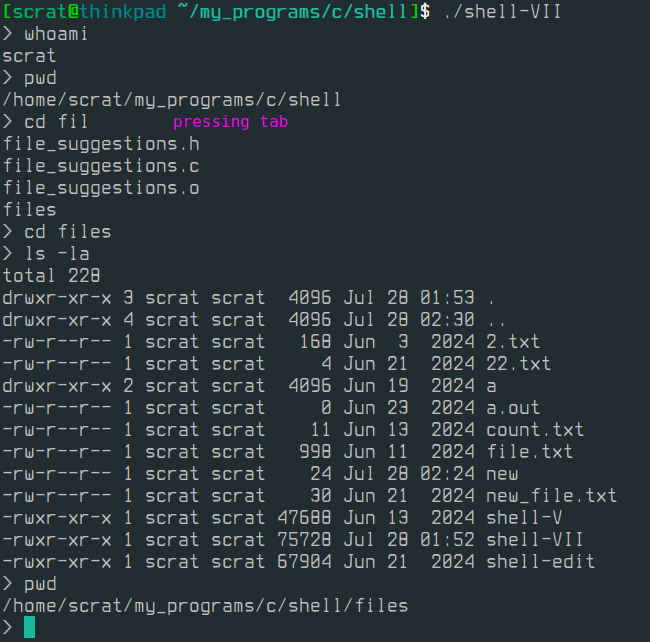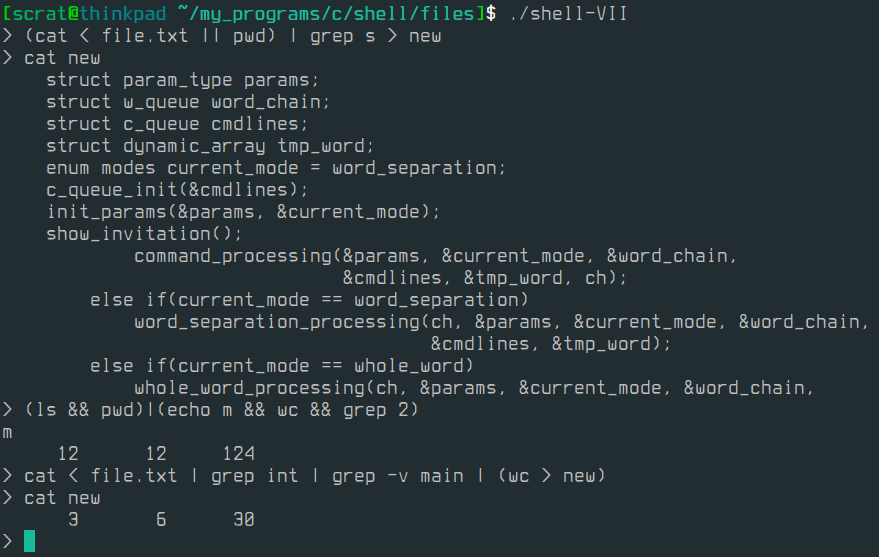# Simple UNIX Shell
A lightweight command-line shell implemented in C, designed to emulate core
functionalities of UNIX shells like `sh` or `bash`. This shell supports
**process management**, **I/O redirection**, **pipelining (|)**, **subshells**,
**logical operators (&&, ||)**, **interactive input handling including
autocompletion** and **basic signal handling**. The implementation demonstrates
system-level programming concepts using **POSIX APIs**.

 ---
## Features
- **Command Execution**
Executes external programs using `fork()` and `execvp()`, with environment lookup
via `$PATH`.
- **Foreground and background job execution**
Commands can be run in the background by appending `&`.
- **Redirection**
Input/output redirection using `<`, `>`, and `>>`. _Examples:_
- `cat < input.txt`
- `ls > out.txt`
- `echo foo >> log.txt`
- **Quoting and escape sequences**
Basic support for `"quoted strings"` and escape sequences like `\ ` or `\"`.
- **Logical Operators**
Implements support for `&&` and `||` operators, enabling conditional command
execution. These operators can be combined with pipelines and subshells.
- **Subshells**
Commands enclosed in parentheses `()` are executed in subshells,
enabling complex nested logic.
- **Pipelines**
Unix-style pipelines using the pipe (|) operator. Data is passed from one
process to another via standard input/output.
_Example: `cat file.txt | grep foo | sort`_
- **Directory Navigation**
Supports the built-in `cd` command to change the current working directory via
`chdir()`.
- **Autocompletion (Tab)**
Custom autocompletion implemented using raw terminal input:
- If the current token is a command: matches against executables in `$PATH`.
- Otherwise: matches file and directory names from the current or specified path.
- **Interactive Line Editing**
Terminal is switched to non-canonical mode. Input handling is implemented manually:
- Character-by-character input display.
- Left/right arrow keys for cursor movement.
- `Backspace` support with live line re-rendering.
- `Ctrl+D` to terminate the shell.
- `Tab` triggers autocompletion.
- **Signal handling**
Handles SIGCHLD to reap zombie processes and prevent defunct children.
---
## Technologies Used
- **Language**: C (C99)
- **System APIs**: POSIX (`fork`, `execvp`, `waitpid`, `pipe`, `dup2`, `tcsetpgrp`, etc.)
- **Memory handling**: dynamic memory allocation (`malloc`, `free`)
- **Terminal control**: `tcgetpgrp`, `tcsetpgrp`, `tcgetattr`, `tcsetattr`
---
## Limitations
While the shell supports many core UNIX behaviors, it has some limitations compared to full-featured shells:
- No scripting constructs (`if`, `while`, `for`, etc.)
- No variable expansion (e.g. `$HOME`, `$PATH`, `$?`)
- No command substitution (e.g. `` `command` `` or `$(command)`)
- No history (up arrow)
- No job control (e.g. fg, bg, jobs).
- No advanced signal features (sigaction, sigprocmask, kill, etc.).
You’ll see a prompt where you can enter commands, use pipes, redirection, and
job control. You can also interact via signals like Ctrl+C and Ctrl+Z.
---
## Features
- **Command Execution**
Executes external programs using `fork()` and `execvp()`, with environment lookup
via `$PATH`.
- **Foreground and background job execution**
Commands can be run in the background by appending `&`.
- **Redirection**
Input/output redirection using `<`, `>`, and `>>`. _Examples:_
- `cat < input.txt`
- `ls > out.txt`
- `echo foo >> log.txt`
- **Quoting and escape sequences**
Basic support for `"quoted strings"` and escape sequences like `\ ` or `\"`.
- **Logical Operators**
Implements support for `&&` and `||` operators, enabling conditional command
execution. These operators can be combined with pipelines and subshells.
- **Subshells**
Commands enclosed in parentheses `()` are executed in subshells,
enabling complex nested logic.
- **Pipelines**
Unix-style pipelines using the pipe (|) operator. Data is passed from one
process to another via standard input/output.
_Example: `cat file.txt | grep foo | sort`_
- **Directory Navigation**
Supports the built-in `cd` command to change the current working directory via
`chdir()`.
- **Autocompletion (Tab)**
Custom autocompletion implemented using raw terminal input:
- If the current token is a command: matches against executables in `$PATH`.
- Otherwise: matches file and directory names from the current or specified path.
- **Interactive Line Editing**
Terminal is switched to non-canonical mode. Input handling is implemented manually:
- Character-by-character input display.
- Left/right arrow keys for cursor movement.
- `Backspace` support with live line re-rendering.
- `Ctrl+D` to terminate the shell.
- `Tab` triggers autocompletion.
- **Signal handling**
Handles SIGCHLD to reap zombie processes and prevent defunct children.
---
## Technologies Used
- **Language**: C (C99)
- **System APIs**: POSIX (`fork`, `execvp`, `waitpid`, `pipe`, `dup2`, `tcsetpgrp`, etc.)
- **Memory handling**: dynamic memory allocation (`malloc`, `free`)
- **Terminal control**: `tcgetpgrp`, `tcsetpgrp`, `tcgetattr`, `tcsetattr`
---
## Limitations
While the shell supports many core UNIX behaviors, it has some limitations compared to full-featured shells:
- No scripting constructs (`if`, `while`, `for`, etc.)
- No variable expansion (e.g. `$HOME`, `$PATH`, `$?`)
- No command substitution (e.g. `` `command` `` or `$(command)`)
- No history (up arrow)
- No job control (e.g. fg, bg, jobs).
- No advanced signal features (sigaction, sigprocmask, kill, etc.).
You’ll see a prompt where you can enter commands, use pipes, redirection, and
job control. You can also interact via signals like Ctrl+C and Ctrl+Z.

 ---
## Features
- **Command Execution**
Executes external programs using `fork()` and `execvp()`, with environment lookup
via `$PATH`.
- **Foreground and background job execution**
Commands can be run in the background by appending `&`.
- **Redirection**
Input/output redirection using `<`, `>`, and `>>`. _Examples:_
- `cat < input.txt`
- `ls > out.txt`
- `echo foo >> log.txt`
- **Quoting and escape sequences**
Basic support for `"quoted strings"` and escape sequences like `\ ` or `\"`.
- **Logical Operators**
Implements support for `&&` and `||` operators, enabling conditional command
execution. These operators can be combined with pipelines and subshells.
- **Subshells**
Commands enclosed in parentheses `()` are executed in subshells,
enabling complex nested logic.
- **Pipelines**
Unix-style pipelines using the pipe (|) operator. Data is passed from one
process to another via standard input/output.
_Example: `cat file.txt | grep foo | sort`_
- **Directory Navigation**
Supports the built-in `cd` command to change the current working directory via
`chdir()`.
- **Autocompletion (Tab)**
Custom autocompletion implemented using raw terminal input:
- If the current token is a command: matches against executables in `$PATH`.
- Otherwise: matches file and directory names from the current or specified path.
- **Interactive Line Editing**
Terminal is switched to non-canonical mode. Input handling is implemented manually:
- Character-by-character input display.
- Left/right arrow keys for cursor movement.
- `Backspace` support with live line re-rendering.
- `Ctrl+D` to terminate the shell.
- `Tab` triggers autocompletion.
- **Signal handling**
Handles SIGCHLD to reap zombie processes and prevent defunct children.
---
## Technologies Used
- **Language**: C (C99)
- **System APIs**: POSIX (`fork`, `execvp`, `waitpid`, `pipe`, `dup2`, `tcsetpgrp`, etc.)
- **Memory handling**: dynamic memory allocation (`malloc`, `free`)
- **Terminal control**: `tcgetpgrp`, `tcsetpgrp`, `tcgetattr`, `tcsetattr`
---
## Limitations
While the shell supports many core UNIX behaviors, it has some limitations compared to full-featured shells:
- No scripting constructs (`if`, `while`, `for`, etc.)
- No variable expansion (e.g. `$HOME`, `$PATH`, `$?`)
- No command substitution (e.g. `` `command` `` or `$(command)`)
- No history (up arrow)
- No job control (e.g. fg, bg, jobs).
- No advanced signal features (sigaction, sigprocmask, kill, etc.).
You’ll see a prompt where you can enter commands, use pipes, redirection, and
job control. You can also interact via signals like Ctrl+C and Ctrl+Z.
---
## Features
- **Command Execution**
Executes external programs using `fork()` and `execvp()`, with environment lookup
via `$PATH`.
- **Foreground and background job execution**
Commands can be run in the background by appending `&`.
- **Redirection**
Input/output redirection using `<`, `>`, and `>>`. _Examples:_
- `cat < input.txt`
- `ls > out.txt`
- `echo foo >> log.txt`
- **Quoting and escape sequences**
Basic support for `"quoted strings"` and escape sequences like `\ ` or `\"`.
- **Logical Operators**
Implements support for `&&` and `||` operators, enabling conditional command
execution. These operators can be combined with pipelines and subshells.
- **Subshells**
Commands enclosed in parentheses `()` are executed in subshells,
enabling complex nested logic.
- **Pipelines**
Unix-style pipelines using the pipe (|) operator. Data is passed from one
process to another via standard input/output.
_Example: `cat file.txt | grep foo | sort`_
- **Directory Navigation**
Supports the built-in `cd` command to change the current working directory via
`chdir()`.
- **Autocompletion (Tab)**
Custom autocompletion implemented using raw terminal input:
- If the current token is a command: matches against executables in `$PATH`.
- Otherwise: matches file and directory names from the current or specified path.
- **Interactive Line Editing**
Terminal is switched to non-canonical mode. Input handling is implemented manually:
- Character-by-character input display.
- Left/right arrow keys for cursor movement.
- `Backspace` support with live line re-rendering.
- `Ctrl+D` to terminate the shell.
- `Tab` triggers autocompletion.
- **Signal handling**
Handles SIGCHLD to reap zombie processes and prevent defunct children.
---
## Technologies Used
- **Language**: C (C99)
- **System APIs**: POSIX (`fork`, `execvp`, `waitpid`, `pipe`, `dup2`, `tcsetpgrp`, etc.)
- **Memory handling**: dynamic memory allocation (`malloc`, `free`)
- **Terminal control**: `tcgetpgrp`, `tcsetpgrp`, `tcgetattr`, `tcsetattr`
---
## Limitations
While the shell supports many core UNIX behaviors, it has some limitations compared to full-featured shells:
- No scripting constructs (`if`, `while`, `for`, etc.)
- No variable expansion (e.g. `$HOME`, `$PATH`, `$?`)
- No command substitution (e.g. `` `command` `` or `$(command)`)
- No history (up arrow)
- No job control (e.g. fg, bg, jobs).
- No advanced signal features (sigaction, sigprocmask, kill, etc.).
You’ll see a prompt where you can enter commands, use pipes, redirection, and
job control. You can also interact via signals like Ctrl+C and Ctrl+Z.